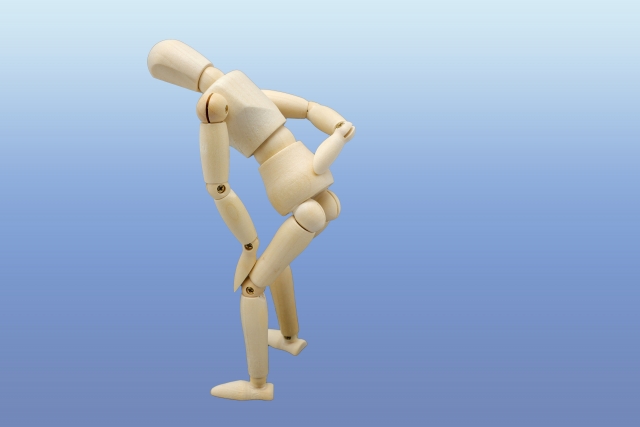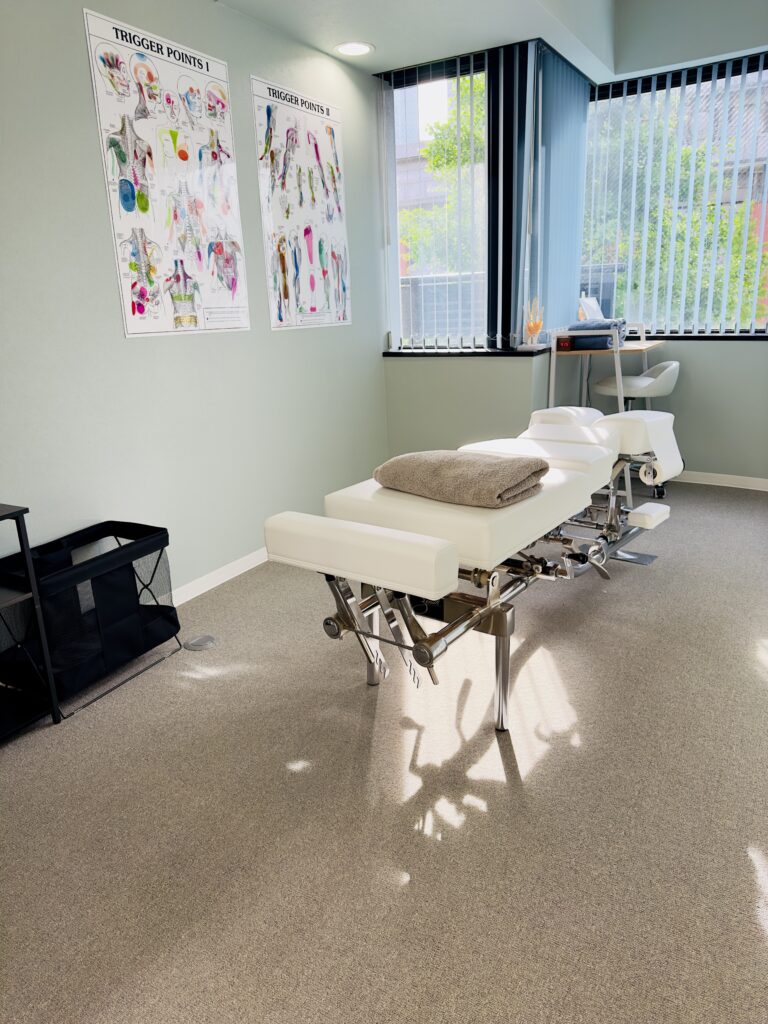A 40-year-old male experiences sudden lower back pain on top of chronic back pain
A company employee living in Kannai came to the clinic after experiencing a sudden acute lower back pain (known as “gikkuri-goshi”) while standing up from a chair at work.
The symptoms included intense pain in the left lower back and a noticeable limp as the patient arrived at the clinic.

[Background and Current Condition]
The patient had been experiencing chronic lower back pain and, due to spending long hours at a desk for work, made a conscious effort to stand up slowly from his chair. Although he did not have a regular exercise routine, he made it a point to walk rather than use a car when going out on his days off.
He noticed that moving around would temporarily alleviate the back pain, so he tried to stay active even at work. However, since the onset of the COVID-19 pandemic, he began teleworking, which significantly reduced his physical activity. As a result, he felt that the frequency of his lower back pain had increased in recent years.
[Initial Symptoms]
Interview:
During the interview, the patient sat while discussing the condition but had to keep it brief and stand because the pain became severe when standing up from a seated position. The pain was located on the left side, and even slight movements triggered intense pain, making movement difficult. The patient mentioned that due to the inability to sit and work, they took time off from work and spent almost three days lying down at home.
The pain was most pronounced during flexion movements, to the extent that the patient could barely bend. Extension movements (arching backward) were less painful, and the patient could perform these movements.
The patient struggled significantly when getting out of bed and found it very difficult to perform tasks such as putting on pants or socks, washing their face, and standing up from a chair.
Visual Inspection:
The interview was conducted while standing, and it was observed that the patient assumed a pain-avoidant posture, clearly leaning their weight to the right side to alleviate discomfort.
Static Palpation:
When examined in the prone position (lying face down), there was a marked difference in the tension of the left and right spinal erector muscles and the quadratus lumborum. Additionally, the normal lumbar lordosis was completely absent, leaving the spine in a flat position.
Due to the intense pain, the supine position (lying face up) was not examined during the initial assessment but would be checked during subsequent treatment.
Motion Palpation:
Since the pain was severe, the examination was limited to the prone position. However, due to the consistent triggering of left-sided lower back pain with any movement, this examination was not conducted further.
Orthopedic Tests:
・Adams Sign: Positive (+) for left lower back pain
・Neri Bowing Test: Negative (-)
・Straight Leg Raise (SLR): Negative (-)
・Bechterew’s Sitting Test: Not performed (patient was not seated)
・Valsalva Maneuver: Negative (-)
・Belt Test: Not performed
Muscle Strength Examination:
Due to the pain, this test was not performed.

Men have the highest incidence rate of lower back pain.
[Treatment Content]

Due to the intensity of the pain, the treatment was performed on a specialized bed, with the bed angle slightly elevated to create an anti-gravity position. The treatment focused on reducing the tension in the spinal erector muscles, quadratus lumborum, and gluteal muscles. However, since excessively relaxing the muscles could lead to a decrease in core stability, the goal was not to simply relax the muscles but to enhance their flexibility as a “functional improvement.”
The most fundamental issue that needed to be addressed was the loss of lumbar lordosis. With care and precision, the treatment involved using the “Joint motion” theory to improve the range of motion and the shape of the lumbar spine.
[Prognosis]
First Session:
Although the pain remained, the patient was visibly impressed with the immediate relief experienced when getting up from the bed and walking after the treatment. Lifestyle advice was provided before concluding the session. Given the acute nature of the symptoms, a follow-up appointment was recommended for three days later.
Second Session (3 days later):
The patient still experienced significant pain in the mornings, particularly when getting out of bed, which remained a challenge. However, there was considerable relief in daytime pain, making activities like standing up from a chair much easier. It was suggested to schedule the next appointment with a slightly longer interval, one week later.
Third Session (1 week later):
After two sessions, there was a significant reduction in pain, with daytime pain nearly disappearing. Although the patient still experienced some stiffness when getting out of bed in the morning, it was not painful, and as long as he was careful when rising, he could go about his day without issue. Since the pain relief was maintained for a week, it was decided to extend the interval to two weeks for the next session.
Fourth Session (2 weeks later):
After the third session, the patient’s work became suddenly busier, leading to increased overtime at home. This resulted in a severe condition one week later. The patient considered calling the clinic, but after performing the stretches taught at Spine Chiropractic on the night when the lower back pain intensified, he experienced relief. The patient continued to perform the stretches diligently every night, which stabilized the symptoms, and he came in two weeks later.
While it was positive that the symptoms were relieved through stretching, there was a noticeable difference in the tension of the left and right lumbar erector spinae muscles, so a thorough balance adjustment was carried out as in the first session. The loss of lumbar lordosis was also more pronounced, so additional time was spent on treatment.
The extended interval of two weeks between sessions, combined with prolonged sitting, likely contributed to the exacerbation, so the patient was advised to return for the fifth session in one week.
Fifth Session (1 week later):
The patient reported almost no pain and was diligently performing the stretches every night, leading to the conclusion of chiropractic treatment based on the patient’s judgment.
Sixth Session (1.5 months later):
The patient experienced a decline in condition, with ongoing lower back pain, though not another acute episode. The patient also noticed that the stretches were becoming less effective, prompting a return to the clinic.
After the treatment, the patient felt significant relief and expressed a desire to transition to maintenance care.
Currently, the patient continues with preventive chiropractic treatment once a month for the past three months.
[Practitioner’s Opinion]
Lumbago (Sudden Lower Back Pain)…
Many of you over 40 might have experienced it at least once.
Also known as the “Witch’s Strike,” this condition is characterized by sudden, severe pain. Some people might feel chronic lower back pain leading up to it, while others might be struck by intense pain out of the blue.
However, it’s important not to assume that being pain-free means you’re healthy, or that mild discomfort is nothing to worry about. Common nerve-related conditions include herniated discs and spinal stenosis. (Other conditions such as muscular dystrophy, Parkinson’s disease, myasthenia gravis, amyotrophic lateral sclerosis, and others are outside the scope of chiropractic care and should be promptly addressed by a medical doctor.)
Even conditions not related to nerve issues, such as chronic pain syndrome, rheumatoid arthritis, gout/pseudogout, fibromyalgia, muscle pain, hyperuricemia, osteoporosis, chronic fatigue syndrome, and more can be problematic. However, the most common conditions in daily life that are typically treated with chiropractic care are muscle fatigue-related pain, chronic tension, spasms resulting from prolonged muscle tension, and chronic muscle pain.
This patient’s condition resulted from continued tension in the lumbar spinal erector muscles, quadratus lumborum, and iliopsoas muscles, which led to a sudden onset of lumbago.
Additionally, the patient likely had a pre-existing tendency for a loss of lumbar lordosis. Without addressing not only the muscles but also the structural changes in the skeletal system, the condition could easily recur.
Currently, the patient is maintaining a good condition through ongoing maintenance and has not experienced a recurrence. At Spine Chiropractic, we focus not only on determining whether a condition is suitable for chiropractic care but also on providing treatments that aim to address the root cause and prevent recurrence.
If you work or live in the Yokohama area, including Kannai, Sakuragicho, Bashamichi, or Nihon Odori, and are struggling with lumbago or lower back pain, please visit Spine Chiropractic. I am committed to providing care with sincerity and dedication.